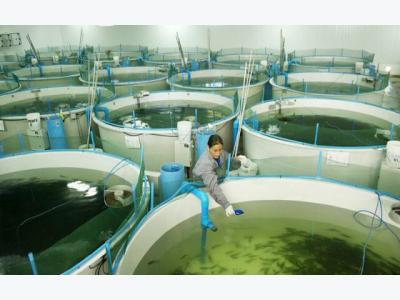Challenges of RAS technology

Lack of suitably experienced RAS managers and operators. Former cage or hatchery managers are not necessarily sufficiently well qualified to operate commercial scale RAS fattening farms without minimum 6-10 months training on the job. Poor awareness in terms of the broad range of water quality variables that require 24h in-line monitoring – especially in marine RAS.
While RAS farms enable operators to avoid any release of particulate solid or dissolved nutrient waste into recipient waters its questionable how many investors take this issue seriously or appreciate the costs of implementing waste management into the production programme.
Investors in RAS technology, even those with aquaculture experience, generally know little about water quality control, sea water chemistry and waste management at the industrial scale. Equally, RAS technology suppliers often know little about aquaculture and / or have a weak biological background.
Investors fail to prepare adequately when identifying an appropriate RAS technology package – hence the large number of commercial failures
Conclusion about economic viability of a RAS project is often based on assumptions and variables related to expected market price, utilization of the waste stream, product quality, optimal and maximum densities achievable, energy costs and costs relating to depreciation and interest on loans. Some of these criteria are subject to change and where assumptions are based solely on small pilot or research projects then even greater caution is required.
Production of species preferring warmer water (20-25oC) can be advantageous both from a growth rate standpoint but also in terms of energy conservation. Maintaining optimum water temperatures for species like sea bass or bream, as opposed to species like turbot or halibut, is likely to be less
RAS Technologies and their commercial application – final report Stirling Aquaculture Page 15
energy demanding in the UK provided the farm buildings are properly insulated21. Alternatively, if reliable, consistent low cost methods of cooling can be assured then the options for farming a range of temperate and cold water species alongside higher value Mediterranean or even tropical species are broadened. Experienced technicians to work with these species will need to be recruited from abroad.
Species selection for UK RAS production is a critical issue. Irrespective of sustainability arguments for RAS production, the farm still needs to make a profit. Production of a commodity species in RAS which has to compete with the same product either imported or farmed using a lower production cost method requires serious risk assessment. The development of commercial scale marine RAS in the UK has focussed on the higher value seafood species such as European sea bass. However, this production still has to compete with large volumes of low priced imported product from the Mediterranean even though the latter is of inferior quality and not necessarily farmed with the same degree of sustainability.
Ironically, superior prices can be secured in overseas markets for UK RAS farmed sea bass which is counter to the argument of building RAS close to the domestic market. Once effective RAS production becomes more widely deployed then options for the export of UK RAS production becomes more restricted and large scale farms producing in excess of 400-500 tonnes per annum will struggle to secure a premium price in the UK market for their entire annual production unless they can dominate the market with volume production and diversified value added products.
Dependency on securing a premium price for a RAS farmed product justified by sustainability criteria may not always hold true. This is particularly so in terms of energy demand, energy source and associated carbon footprint.
Reducing operational costs of RAS farms through utilisation of farm waste for value added products is perfectly feasible but is often over-played by developers. RAS farm effluent takes the form of a mobile sludge and dissolved nutrient streams which can be readily recycled into value added products such as composts, micro-algae and polychaete worms. However, the argument that parallel production of polychaete worms in RAS farm waste would be sufficient to totally substitute fish meal in feeds for the farm requires very close scrutiny - even if the polychaetes were nutritionally adequate as fish meal substitutes. The management of RAS farm sludge is a very real issue which few developers seem to properly appreciate at the outset of the project.
The utilisation of RAS farm waste for on-site energy production is also feasible and the potential contribution in trial studies indicates this approach could be useful (Mirzoyan et et al., 2008; 2010). However, the investment in anaerobic digesters and equipment for conversion of gases to usable energy needs to be carefully balanced against the potential savings in power consumption. EU research into the potential of RAS farm waste as an energy source is currently underway (BiFFio - FP7: Research for the benefit of SME-AG) but this programme is focussed on the contribution of RAS aquaculture waste to energy production off-site and in combination with the larger volumes of agricultural waste. This approach will not necessarily benefit the RAS farm as it may still incur costs to transport the waste off-site under license. Ideally, energy generation utilising RAS farm waste should be implemented on site and this option should become increasingly attractive with larger farm sizes.
Related news
 Laval shrimp nutrition
Laval shrimp nutrition Astable supply of high-quality postlarvae (PL) is an essential requirement to guarantee the future sustainability of shrimp production.
 Intensive Farm In Bali, Indonesia, Produces Shrimp In Biofloc System
Intensive Farm In Bali, Indonesia, Produces Shrimp In Biofloc System Bali Island in Indonesia is a popular tourist destination. However, a few aquaculture facilities, including small shrimp farms
 Effects of Sterol supplements on Shrimp Growth, Survival
Effects of Sterol supplements on Shrimp Growth, Survival A study found the quality and levels of sterols in experimental feeds affected the growth performance of Pacific white shrimp.